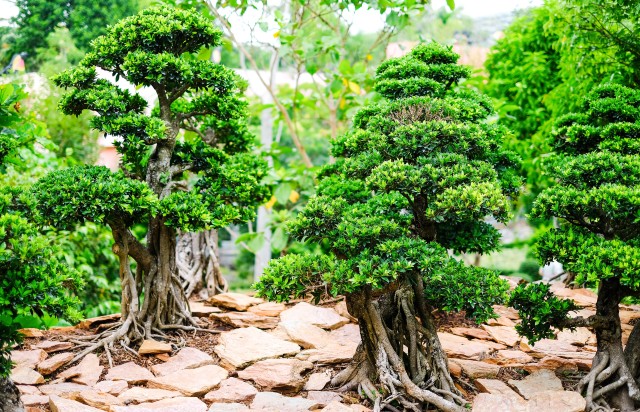Have you ever wondered how long it takes for a bonsai tree to grow? Well, buckle up because we’re about to take you on a journey through the fascinating world of bonsai cultivation.
In this article, we’ll explore the historical perspective, factors that affect growth, and different species’ growth rates. We’ll also delve into pruning and shaping techniques, as well as tips for accelerating growth.
So, grab a cup of tea and get ready to discover the art of patience and time commitment in bonsai cultivation.
Historical Perspective
If you’re interested in the historical perspective of bonsai trees, you’ll be amazed at how this ancient art form has been practiced for centuries.
Bonsai has a rich historical significance, dating back over a thousand years to ancient China and Japan.
In China, bonsai was initially developed as a form of horticultural therapy for the elite class. It was later adopted by Japan, where it became deeply rooted in their culture and gained cultural symbolism.
Bonsai trees were seen as a representation of harmony between man and nature, and they were often displayed during important ceremonies and in the homes of nobles.
Throughout history, bonsai has continued to evolve and gain popularity worldwide, making it a truly enduring art form with a fascinating historical background.
Factors Affecting Growth
The factors that affect the growth of a bonsai tree include soil quality, sunlight exposure, and watering frequency. To ensure proper growth, you need to consider the fertilizer requirements and environmental conditions as well.
When it comes to soil quality, bonsai trees thrive in well-draining soil that is rich in organic matter. This allows the roots to breathe and absorb nutrients effectively.
Sunlight exposure is crucial as it provides the energy needed for photosynthesis. Place your bonsai tree in a location where it can receive sufficient sunlight, but be mindful of excessive heat or cold drafts.
Watering frequency is another vital factor. Bonsai trees require regular watering, but be careful not to overwater as it can lead to root rot.
Lastly, be mindful of the specific fertilizer requirements for your bonsai tree, as different species may have different nutrient needs.
Growth Rates of Different Species
To determine the growth rates of different species, you should research and compare the specific requirements and characteristics of each type of bonsai tree.
Different species of bonsai trees have varying growth rates, which are influenced by factors such as sunlight, temperature, watering, and pruning techniques. For example, some species like the Japanese Black Pine grow relatively faster compared to others like the Juniper.
Understanding the care requirements of each species is essential in promoting their growth and maintaining their health. Factors such as the amount of sunlight, humidity levels, soil type, and nutrient needs can greatly impact the growth rates of bonsai trees.
Pruning and Shaping Techniques
Pruning and shaping techniques are essential for maintaining the desired form and appearance of bonsai trees. When it comes to pruning techniques, you need to carefully remove any dead, damaged, or overgrown branches to promote healthy growth. This helps to maintain the overall shape and balance of the tree.
You can also use pruning to create more space between branches, allowing light to reach the inner parts of the tree. Shaping methods, on the other hand, involve manipulating the tree’s growth patterns to achieve a specific style. This can be done through wiring, where you gently bend the branches into the desired position. Remember to regularly check the wires to prevent them from cutting into the bark.
With proper pruning and shaping, you can create stunning bonsai trees that reflect your artistic vision.
Patience and Time Commitment
Maintaining a bonsai tree requires patience and a significant time commitment. You must understand that bonsai trees are not like regular houseplants. They require constant care and attention to thrive.
It takes patience to carefully prune and shape the tree, ensuring that it maintains its desired form. It also takes dedication to regularly water, fertilize, and protect the bonsai from pests and diseases.
Bonsai trees are living works of art that require your commitment. You must be willing to invest time into learning about their specific needs and techniques for proper care.
Tips for Accelerating Growth
Watering regularly and providing adequate sunlight can help speed up the growth of your bonsai tree.
However, there are additional techniques you can use to further accelerate its growth and maximize its potential.
One important technique is pruning. By carefully trimming the branches and roots, you can stimulate new growth and shape your bonsai tree into the desired form.
Another technique is fertilizing. Using a balanced bonsai fertilizer can provide the necessary nutrients for your tree to thrive and grow at a faster rate.
Additionally, repotting your bonsai tree every few years can help rejuvenate its roots and encourage fresh growth.
Lastly, ensuring proper airflow and humidity levels in your bonsai’s environment can also contribute to its accelerated growth.
Enjoying the Journey
Now that you’ve learned some tips for accelerating the growth of your bonsai tree, let’s shift our focus to something equally important – enjoying the journey.
Bonsai cultivation is not just about the end result; it’s about embracing the process and finding mindfulness in each step. Take the time to observe the intricate details of your tree, from the delicate leaves to the twisting branches. Notice the way the sunlight filters through the foliage and the calming sound of water as you nourish your bonsai.
Conclusion
In conclusion, growing a bonsai tree requires patience and dedication. Depending on the species, it can take several years or even decades for a bonsai tree to reach its desired size and shape.
However, with proper care, pruning, and shaping techniques, you can accelerate the growth process. Remember to enjoy the journey and appreciate the beauty of your bonsai tree as it gradually transforms into a stunning work of art.
